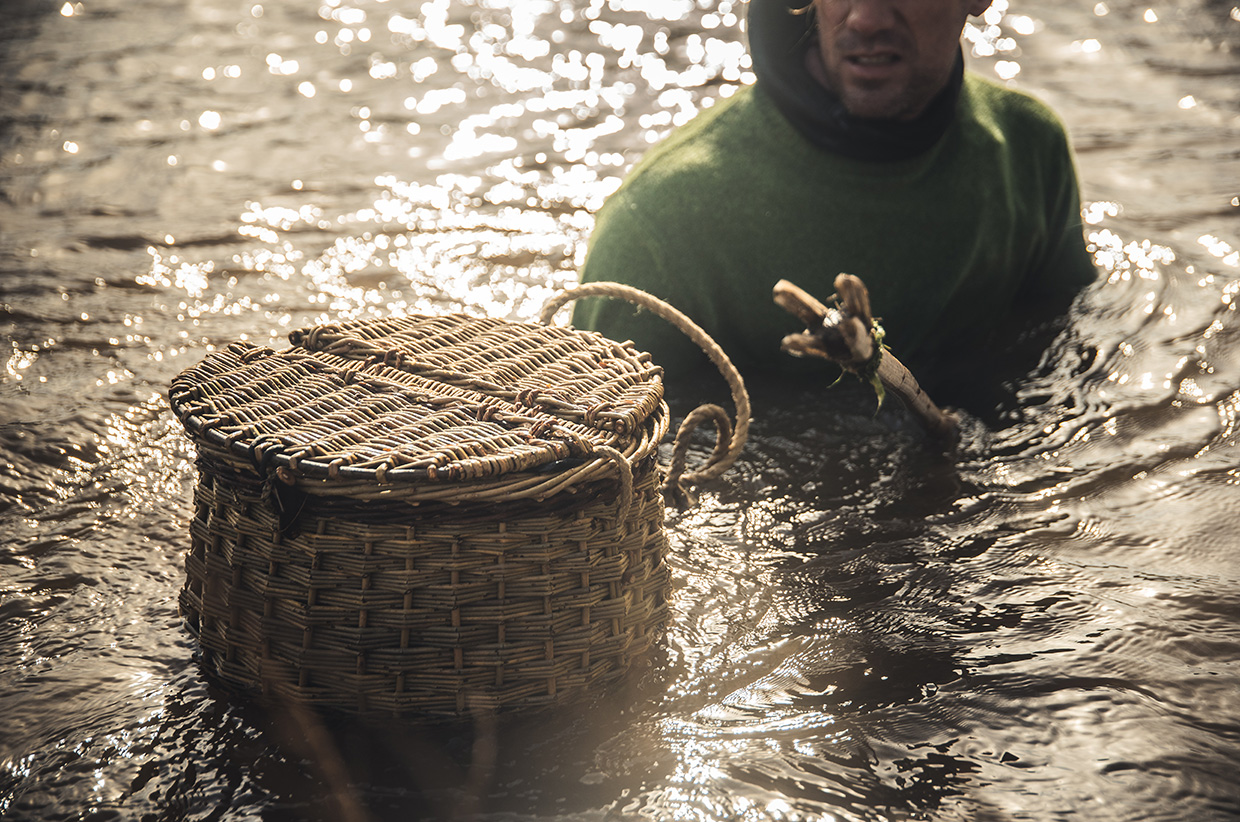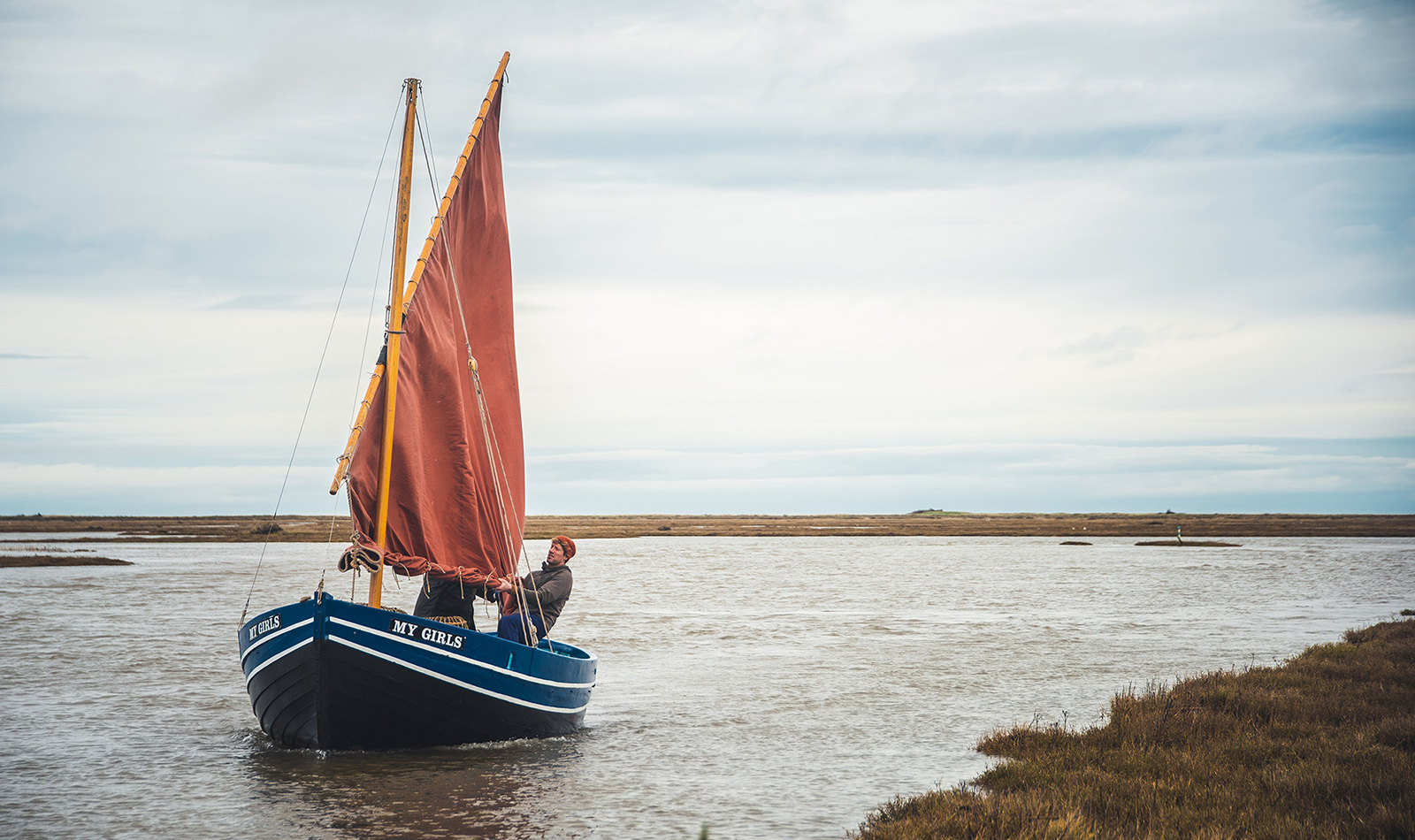Boat. Swim. Forage.
A sailboat journey along the Norfolk Coastline
Written by Henry Chamberlain // Photography by Ian Finch
Produced in partnership with Filson
Adventure, tradition, foraging – never before have some of these key elements been so relevant or important. When we see empty supermarkets, closed shops, and transportation hubs grinding to a halt, we are reminded of the importance of age-old skills that connect us with the land and sea for our well-being, livelihoods, and even survival. Nature is fiercely reminding us that the fast-moving, tech-driven world is fragile and that she will always have the final word. The fading knowledge of traditional coastal boating and foraging skills suddenly come sharply into focus and are considered vital again. Those that can work the land and sea are the people that have the mindset, knowledge, and skills to thrive during difficult times.
My Girls, our open wooden 20ft crab boat with original 1960s larch planks on oak frames, stirs into life as we hoist her simple lug-rig sail, as local fishermen have done for many centuries along these treacherous shallow waters. She was made for these seas, with shallow draft and long flat keel, and she’s beamy enough to safely cross sandbanks and carry our working gear. The light south-westerly wind of a misty spring morning lazily fills her red sails as the sun tries to warm the wild North Norfolk salt marsh surrounding Wells-next-the-Sea. The salty smell of the sea and wind stirs our blood. We are lucky. The following winds enable us to navigate deep into one of the UK’s last wild places – we are off to quench our thirst for adventure and forage for our evening meal.
We glide effortlessly with the strong tide, deeper into our waterlogged world, navigating mud banks, false turns, and hidden obstacles as the curlews and oystercatchers sing for us with their enchanting high-pitched cries and warbles. We are going as far as our experienced vessel will take us, to some protected water where we can anchor her up before the next stage of our morning routine.



To access the best foraging sites, it’s possible to walk on to the sandbanks at low tide, but you have to wait longer and the route is precarious with thick mud; we prefer to harness nature’s energy and slip over the side of our plucky boat, using the opportunity for a morning workout with a wild swim, powered by the outgoing tide. Our detailed tidal planning and experience pay off. Our willow foraging baskets, hazel spears and essential supplies are tethered round our waists with a piece of hemp rope tied in a bowline – a knot drilled into me during my time as a Royal Marines Commando. We swim easily for a kilometre following the creek as it broadens out to reveal a new open and flat sandy world, the secret sandbanks revealed for the first time since the previous tide.
The last remaining seals seek deeper channels and keep a curious eye on the strange intruders. To keep warm, we move fast to our secret larder, freely picking cockles, mussels, and (if we are lucky) oysters.
We swim to a familiar sandbank as the sea drains like bathwater, and pull in our foraging baskets. The last remaining seals seek deeper channels and keep a curious eye on the strange intruders. To keep warm, we move fast to our secret larder, freely picking cockles, mussels, and (if we are lucky) oysters. As the sun rises and starts to warm us further we switch to slowly stalking the same creek that we have just swam, now only inches of water left, four-pronged spears – or butt prickers, as they are locally known – raised in anticipation of a dab or flatfish. We carefully work our bare feet through the cold water, eyes focused for the unmistakable dash the dabs make for freedom as they try to disappear in a cloud of fine North Sea sand, like smoke popped during a carefully orchestrated military operation. The dabs win this time as we fail to find one for our supper.





We glance up and take note of our salty kingdom. The sun appears to slide between the wispy winter clouds, briefly dimming the lights as the winds pick up. We notice a marsh harrier sweeping above while terns fly over their precarious homes on a nearby sandbank. It’s time to go; nature has provided, and we shall not overstay our welcome. Picking up our coastal foraging baskets brimming with bivalves and samphire, we leave the boat where it lies, listed to one side on a remote sandbank. Using an ancient smuggler trail, we exit the marsh in sight of dry land and safety, nature’s bounty firmly secure in the willow baskets that swing over our shoulders.
We will return tomorrow, when tides and wind favour our tricky journey home, through winter’s edge.
For more information visit coastalexplorationcompany.co.uk and follow them on Instagram @coastalexplorationcompany
Photography by Ian Finch.
Produced in partnership with Filson // Filson.com/uk // @filson1897



